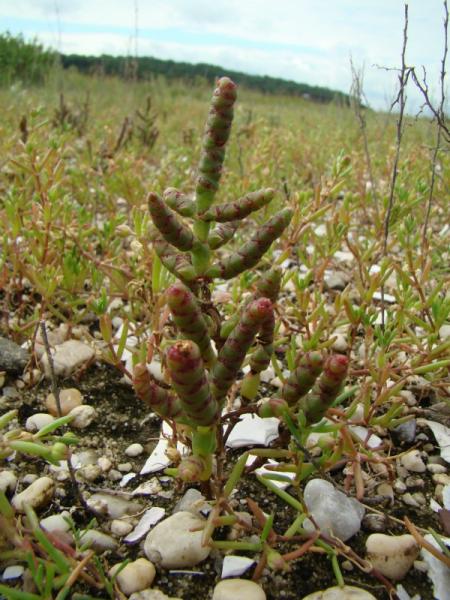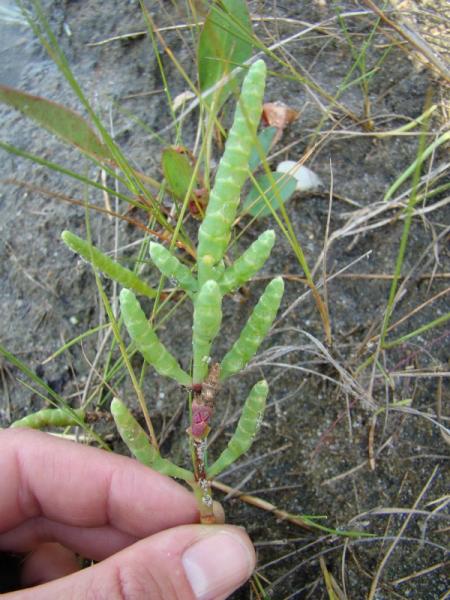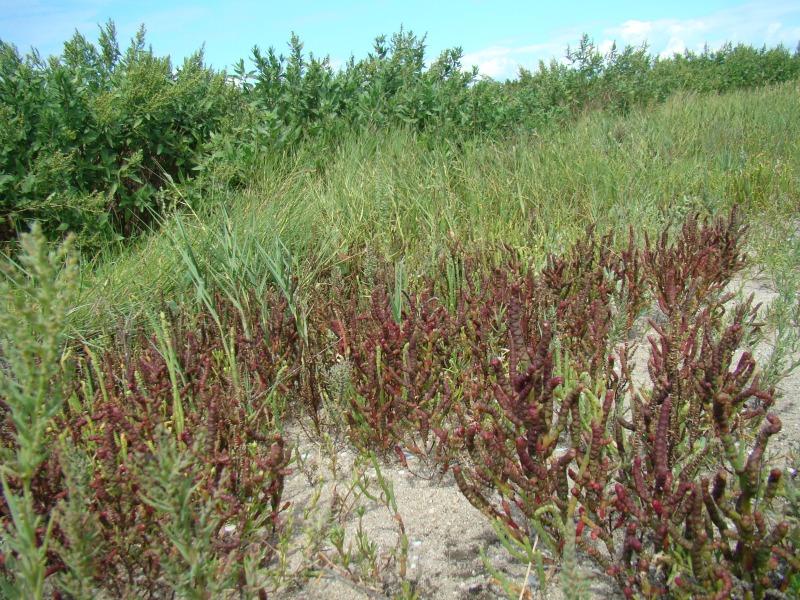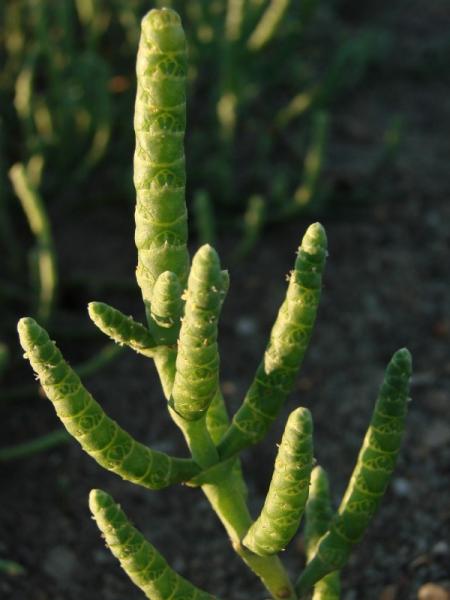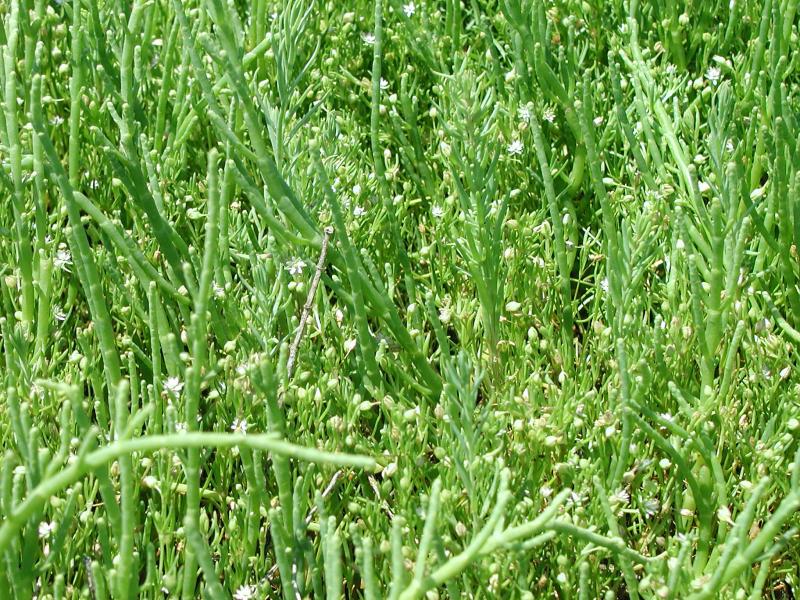Bigelow's Glasswort
Salicornia bigelovii Torr.
- Class
- Dicotyledoneae (Dicots)
- Family
- Amaranthaceae (Amaranth Family)
- State Protection
- Threatened
Listed as Threatened by New York State: likely to become Endangered in the foreseeable future. For animals, taking, importation, transportation, or possession is prohibited, except under license or permit. For plants, removal or damage without the consent of the landowner is prohibited.
- Federal Protection
- Not Listed
- State Conservation Status Rank
- S2S3
Imperiled or Vulnerable in New York - Very vulnerable, or vulnerable, to disappearing from New York, due to rarity or other factors; typically 6 to 80 populations or locations in New York, few individuals, restricted range, few remaining acres (or miles of stream), and/or recent and widespread declines. More information is needed to assign either S2 or S3.
- Global Conservation Status Rank
- G5
Secure globally - Common in the world; widespread and abundant (but may be rare in some parts of its range).
Summary
Did you know?
New York botanist John Torrey named this salt marsh plant after its discoverer Jacob Bigelow, a Harvard professor of medicine and botany who published one of the first two American botanical books with color illustrations. For the illustrations he used etched stone instead of metal plates, an unusual technique at the time (Norman 2006).
State Ranking Justification
There are 12 existing populations but half of these have less than 100 plants each. There are 22 records from the late 1800s through the 1970s that have not been rediscovered.
Short-term Trends
Most of our populations have only been visited one time, so short term trends are unclear, although three of the larger populations seem to be stable.
Long-term Trends
There are almost twice as many historical records as there are current records, so this species seems to have declined over the past 100 years, although many historical sites have not been resurveyed.
Conservation and Management
Threats
Hydrologic changes from ditching and road traffic, as well as invasion of common reed (Phragmites australis) is a threat to some of the salt marshes where this species occurs.
Conservation Strategies and Management Practices
Common Reed should be controlled in the salt marshes where it exists and steps taken to prevent new incursions. Natural buffers should be established around salt marshes to decrease pollution runoff and other direct human disturbances.
Research Needs
Research is needed to determine how this species interacts with other species of Salicornia and what limits its population size within these large marshes.
Habitat
Habitat
In New York dwarf glasswort is known only from maritime wetlands, including high salt marsh, salt panne, and salt shrub natural communities (New York Natural Heritage Program 2011). Middle levels of saltmarshes (FNA 2004). Salt marshes (Crow and Hellquist 2000).
Associated Ecological Communities
- Brackish meadow*
(guide)
A moist, moderately well-drained brackish (salinity 0.5-18 ppt) perennial grassland with occasional isolated shrubs that is typically situated in a belt at the upper edge of salt marshes bordering sandy uplands, but may occupy large portions of interdunal basins. The community usually develops in areas with a unique combination of soils and hydrology, on deep deposits of periodically windblown or overwashed gleyed sands that are usually flooded only during spring tides and during major coastal storms, approximately two to three times per year.
- High salt marsh
(guide)
A coastal marsh community that occurs in sheltered areas of the seacoast, in a zone extending from mean high tide up to the limit of spring tides. It is periodically flooded by spring tides and flood tides. High salt marshes typically consist of a mosaic of patches that are mostly dominated by a single graminoid species.
- Salt panne
(guide)
A shallow depression in a salt marsh where the marsh is poorly drained. Pannes occur in both low and high salt marshes. Pannes in low salt marshes usually lack vegetation, and the substrate is a soft, silty mud. Pannes in a high salt marsh are irregularly flooded by spring tides or flood tides, but the water does not drain into tidal creeks. After a panne has been flooded the standing water evaporates and the salinity of the soil water is raised well above the salinity of sea-water.
- Salt shrub
(guide)
A shrubland community that forms the ecotone between salt marsh and upland vegetation. Salinity levels are generally lower here than in the salt marsh (soil pore salinity ranges 7 ppt to 27 ppt), and the elevation is higher. Salt shrub does not usually develop on deep peat. More often, it occurs on a thin (0-10 cm) layer of peat, and soils share characteristics of both estuarine and maritime terrestrial settings.
* probable association but not confirmed.
Associated Species
- Agalinis maritima
- Agalinis purpurea (purple agalinis)
- Baccharis halimifolia (groundsel-tree)
- Distichlis spicata (salt grass)
- Fimbristylis castanea (marsh fimbry)
- Juncus gerardii
- Limonium carolinianum (sea-lavender)
- Phragmites australis (old world reed grass, old world phragmites)
- Plantago maritima var. juncoides (seaside plantain)
- Sabatia stellaris (sea-pink)
- Salicornia depressa (slender glasswort)
- Salsola kali
- Sarcocornia pacifica
- Solidago sempervirens (northern seaside goldenrod)
- Spartina alterniflora (smooth cord grass)
- Spartina patens (salt-meadow cord grass)
- Suaeda maritima
- Symphyotrichum tenuifolium
- Triglochin maritima (sea arrow-grass)
Range
New York State Distribution
This salt marsh plant is currently known from Suffolk County, Long Island with historical records from Nassau and Queens counties on Long Island and from Staten Island and the Bronx. It has been extirpated from the inland salt marshes near Syracuse.
Global Distribution
This saltmarsh wildflower grows along the Atlantic and Gulf coasts from Southern Maine and New York, where it is rare, south to Florida, and west to Louisiana and the entire coast of Texas. There are also scattered populations in New Mexico and on the southern coast of California.
Identification Comments
General Description
Dwarf Glasswort is an annual, fleshy, erect herb with thick jointed stems (up to 6 mm wide), growing up to 60 centimeters in height (but is often much shorter). Its leaves are opposite, sessile, and fleshy, enclosing the stems, the tips scale-like and mucronate (pointed). The flowers are arranged in triangular groups of 3, emerging from fleshy bracts near the tip of each stem. Each fruit (a utricle) holds a single seed 1 to 1.5 mm long (Gleason and Cronquist 1991). The entire plant, beginning with the tips, may turn red as it ages, especially in autumn.
Best Life Stage for Proper Identification
The key characters for identification are the leaf tips and thick stems, so this species can be identified in either vegetative or reproductive form.
Similar Species
The only other species of Salicornia known from New York is Salicornia depressa. It has obtuse or subacute leaf and bract tips, contrasting with the acute and mucronate leaf tips of S. bigelovii, and its stems are half as thick as S. bigelovii (FNA 2003). Sarcocornia, a closely related genus, has a similar form with fleshy, scale-like leaves. Sarcocornia perennis, the only New York species, differs from Salicornia species in being a perennial, in having many rhizomatous, mat-forming, vegetative stems, and in having its flowers arranged in a row rather than in a triangle.
Best Time to See
The plants emerge in July and may persist until October.
- Vegetative
- Flowering
- Fruiting
The time of year you would expect to find Bigelow's Glasswort vegetative, flowering, and fruiting in New York.
Bigelow's Glasswort Images
Images of Similar Species
Taxonomy
Bigelow's Glasswort
Salicornia bigelovii Torr.
- Kingdom Plantae
- Phylum Anthophyta
- Class Dicotyledoneae
(Dicots)
- Order Caryophyllales
- Family Amaranthaceae (Amaranth Family)
- Order Caryophyllales
- Class Dicotyledoneae
(Dicots)
- Phylum Anthophyta
Additional Common Names
- Chicken-claws
- Dwarf Glasswort
- Glasswort
- Samphire
Synonyms
- Salicornia virginica L. [Misapplied to New York specimens.]
Additional Resources
Best Identification Reference
Crow, Garrett E. and C. Barre Hellquist. 2000. Aquatic and Wetland Plants of Northeastern North America: A revised and enlarged edition of Norman C. Fassett's a Manual of Aquatic Plants. Volume One: Pteridophytes, Gymnosperms, and Angiosperms: Dicotyledons. The University of Wisconsin Press. Madison, Wisconsin. 536 Pages.
Other References
Clemants, Steven and Carol Gracie. 2006. Wildflowers in the Field and Forest. A Field Guide to the Northeastern United States. Oxford University Press, New York, NY. 445 pp.
Flora of North America Editorial Committee. 2003b. Flora of North America North of Mexico. Vol. 4, Magnoliophyta: Caryophyllidae, part 1. Oxford University Press, New York. 559 pp.
Gleason, Henry A. and A. Cronquist. 1991. Manual of Vascular Plants of Northeastern United States and Adjacent Canada. The New York Botanical Garden, Bronx, New York. 910 pp.
Holmgren, Noel. 1998. The Illustrated Companion to Gleason and Cronquist's Manual. Illustrations of the Vascular Plants of Northeastern United States and Adjacent Canada. The New York Botanical Garden, Bronx, New York.
Mitchell, Richard S. and Gordon C. Tucker. 1997. Revised Checklist of New York State Plants. Contributions to a Flora of New York State. Checklist IV. Bulletin No. 490. New York State Museum. Albany, NY. 400 pp.
New York Natural Heritage Program. 2010. Biotics database. New York Natural Heritage Program. New York State Department of Environmental Conservation. Albany, NY.
New York Natural Heritage Program. 2024. New York Natural Heritage Program Databases. Albany, NY.
Newcomb, Lawrence. 1977. Newcomb's Wildflower Guide: An Ingenious New Key System for Quick, Positive Field Identification of the Wildflowers, Flowering Shrubs, and Vines of Northeastern and North-Central North America. Little, Brown and Company. Boston.
Weldy, T. and D. Werier. 2010. New York flora atlas. [S.M. Landry, K.N. Campbell, and L.D. Mabe (original application development), Florida Center for Community Design and Research http://www.fccdr.usf.edu/. University of South Florida http://www.usf.edu/]. New York Flora Association http://newyork.plantatlas.usf.edu/, Albany, New York
Links
About This Guide
Information for this guide was last updated on: November 7, 2011
Please cite this page as:
New York Natural Heritage Program. 2024.
Online Conservation Guide for
Salicornia bigelovii.
Available from: https://guides.nynhp.org/dwarf-glasswort/.
Accessed July 27, 2024.
